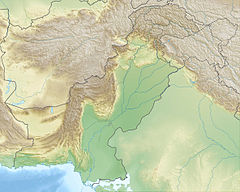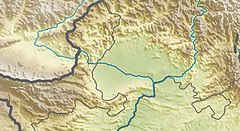Bajaur casket
Appearance
| Bajaur casket | |
|---|---|
 The Bajaur casket, Metropolitan Museum of Art[1] | |
| Created | 1st century CE |
| Discovered | Bajaur |
The Bajaur casket, also called the Indravarma reliquary, year 63,[2] or sometimes referred to as the Avaca inscription,[3] is an ancient reliquary from the area of Bajaur in ancient Gandhara, in the present-day Khyber Pakhtunkhwa, Pakistan. It is dated to around 5–6 CE.[4] It proves the involvement of the Scythian kings of the Apraca, in particular King Indravarman, in Buddhism. The casket is made of schist.
The inscription which is written in Kharoshthi:
| Inscription | Original (Kharosthi script) | Transliteration | English translation |
|---|---|---|---|
| Line 1 | 𐨯𐨎𐨬𐨟𐨿𐨯𐨪𐨀𐨅 𐨟𐨿𐨪𐨅𐨮𐨛𐨁𐨨𐨀𐨅 𐩅 𐩅 𐩅 𐩀 𐩀 𐩀 𐨨𐨱𐨪𐨩𐨯 𐨀𐨩𐨯 𐨀𐨟𐨁𐨡𐨯 𐨐𐨪𐨿𐨟𐨁𐨀𐨯 𐨨𐨯𐨯 𐨡𐨁𐨬𐨯𐨀𐨅 𐨮𐨆𐨜𐨭𐨀𐨅 𐨀𐨁𐨨𐨅𐨞 𐨕𐨅𐨟𐨿𐨪𐨁𐨐 𐨐𐨿𐨮𐨞 𐨀𐨁𐨡𐨿𐨪𐨬𐨪𐨿𐨨𐨅 𐨐𐨂𐨨𐨪𐨅 𐨀𐨤𐨿𐨪𐨕𐨪𐨗𐨤𐨂𐨟𐨿𐨪𐨅 | saṃvatsarae treṣaṭhimae 20 20 20 1 1 1 maharayasa Ayasa atidasa Kartiasa masasa divasae ṣoḍaśae imeṇa cetrika kṣaṇa Idravarme kumare Apracarajaputre | In the year sixty-third - 63 - of the great king Azes I, during the month of Kārttika, on the sixteenth day, at this moment, the Caitrika prince Indravarma, son of the king of Apraca |
| Line 2 | 𐨀𐨁𐨨𐨅 𐨧𐨒𐨬𐨟𐨆 𐨭𐨐𐨿𐨩𐨨𐨂𐨞𐨁𐨯 𐨭𐨪𐨁𐨪 𐨤𐨿𐨪𐨡𐨁𐨛𐨬𐨅𐨟𐨁 𐨛𐨁𐨀𐨀𐨅 𐨒𐨧𐨁𐨪𐨀𐨅 𐨀𐨤𐨿𐨪𐨡𐨁𐨛𐨬𐨁𐨟𐨤𐨿𐨪𐨬𐨅 𐨤𐨟𐨅𐨭𐨅 𐨦𐨿𐨪𐨨𐨿𐨨𐨤𐨂𐨙𐨆 𐨤𐨿𐨪𐨯𐨬𐨟𐨁 𐨯𐨢 𐨨𐨡𐨂𐨞 𐨪𐨂𐨑𐨂𐨞𐨐𐨀 𐨗𐨁𐨤𐨂𐨟𐨿𐨪𐨀𐨅 𐨀𐨤𐨿𐨪𐨕𐨪𐨗𐨧𐨪𐨿𐨩𐨀𐨅 | ime Bhagavato Śakyamuṇisa śarira pradiṭhaveti ṭhiae gabhirae apradiṭhavitaprave pateśe brammapuño prasavati sadha maduṇa Rukhuṇakaa jiputrae Apracarajabharyae | established this relic of the Holy Śākya sage in a secure, deep, and previously unestablished, place. He produces Brahman merit together with his mother Rukhuṇaka, who has a living son, wife of the king of Apraca; |
| Line 3 | 𐨯𐨢 𐨨𐨀𐨂𐨫𐨅𐨞 𐨪𐨨𐨐𐨅𐨞 𐨯𐨢 𐨨𐨀𐨂𐨫𐨞𐨁𐨀𐨅 𐨡𐨮𐨐𐨀𐨅 𐨯𐨢 𐨭𐨿𐨤𐨯𐨡𐨪𐨅𐨱𐨁 𐨬𐨯𐨬𐨡𐨟𐨀𐨅 𐨨𐨱𐨬𐨅𐨡𐨀𐨅 𐨞𐨁𐨐𐨀𐨅 𐨕 𐨒𐨱𐨁𐨞𐨁𐨀𐨅 𐨩 𐨀𐨂𐨟𐨪𐨀𐨅 | sadha maüleṇa Ramakeṇa sadha maülaṇie Daṣakae sadha śpasadarehi Vasavadatae mahavedae Ṇikae ca gahiṇie ya Utarae | together with his maternal uncle Ramaka, together with his maternal uncle's wife Daṣaka, together with his sisters and wife, Vasavadata, Mahaveda, and Ṇika, and the lady of the house, Utara, |
| Line 4 | 𐨤𐨁𐨟𐨂 𐨀 𐨤𐨂𐨩𐨀𐨅 𐨬𐨁𐨮𐨸𐨂𐨬𐨪𐨿𐨨𐨯 𐨀𐨬𐨕𐨪𐨩𐨯 | pitu a puyae Viṣṇuvarmasa Avacarayasa | and in honour of his father Viṣṇuvarma, king of the Apraca. |
| Line 5 | 𐨧𐨿𐨪𐨡 𐨬𐨒 𐨯𐨿𐨟𐨿𐨪𐨟𐨅𐨒𐨆 𐨤𐨂𐨩𐨀𐨁𐨟𐨅 𐨬𐨁𐨗𐨩𐨨𐨁𐨟𐨿𐨪𐨆 𐨩 𐨀𐨬𐨕𐨪𐨩 𐨨𐨡𐨂𐨭𐨿𐨤𐨯 𐨧𐨀𐨁𐨡𐨟 𐨤𐨂𐨩𐨁𐨟 | bhrada Vaga stratego puyaïte Vijayamitro ya Avacaraya maduśpasa Bhaïdata puyita | His brother, Vaga, the general, is honoured, and Vijayamitra, king of the Apraca. His mother's sister Bhaïdata is honoured. |
| Line 6 | 𐨀𐨁𐨨𐨅 𐨕 𐨭𐨪𐨁𐨪𐨅 𐨨𐨂𐨪𐨿𐨩𐨐𐨫𐨁𐨞𐨟𐨅 𐨠𐨂𐨦𐨂𐨟𐨅 𐨐𐨁𐨜𐨤𐨜𐨁𐨱𐨪𐨁𐨀 𐨀𐨵𐨁𐨩𐨅 𐨀𐨱𐨅𐨛𐨁 𐨨𐨗𐨁𐨨𐨨𐨁 𐨤𐨿𐨪𐨟𐨁𐨛𐨬𐨞𐨨𐨁 𐨤𐨿𐨪𐨟𐨁𐨛𐨬𐨁𐨯 | ime ca śarire muryakaliṇate thubute kiḍapaḍiharia avhiye aheṭhi majimami pratiṭhavaṇami pratiṭhavisa | And these relics from a Maurya period stupa, on which a miracle has been performed, are established in a safe, secure, and central establishment |
| Line 7 | 𐨬𐨯𐨁𐨀 𐨤𐨎𐨕𐨀𐨁𐨭𐨆 | vasia paṃcaïśo | vasia fifty |
The inscription was highly useful in clarifying the little-known Apraca dynasty.[3]
Notes
[edit]- ^ Metropolitan Museum of Art [1]
- ^ Nouvelles inscriptions Saka : ère d'Eucratide, ère d'Azès, ère Vikrama, ère de Kaniska, Gérard Fussman, Bulletin de l'École française d'Extrême-Orient, Year 1980 Volume 67 Number 1 pp. 1-44 [2]
- ^ a b Salomon, Richard (1982). "The "Avaca" Inscription and the Origin of the Vikrama Era". Journal of the American Oriental Society. 102 (1): 59–68. doi:10.2307/601111. ISSN 0003-0279.
- ^ Metropolitan Museum of Art.
- ^ Baums, Stefan. (2012). Catalog and Revised Text and Translations of Gandhāran Reliquary Inscriptions. Gandhāran Buddhist Reliquaries. D. Jongeward. Seattle, University of Washington Press
- ^ Bailey, H. W. (1978). "Two Kharoṣṭhī Casket Inscriptions from Avaca". Journal of the Royal Asiatic Society of Great Britain and Ireland (1): 3–13. ISSN 0035-869X.
References
[edit]- Baums, Stefan (2012). "Catalog and Revised Texts and Translations of Gandharan Reliquary Inscriptions". In Jongeward, David; Errington, Elizabeth; Salomon, Richard; Baums, Stefan (eds.). Gandharan Buddhist Reliquaries. Gandharan Studies. Vol. 1. Seattle: Early Buddhist Manuscripts Project. pp. 207–208.
- Baums, Stefan; Glass, Andrew. "Relic Inscription of Iṃdravaṃma". Catalog of Gāndhārī Texts. CKI 242.
- Salomon, Richard (1982). "The "Avaca" Inscription and the Origin of the Vikrama Era". Journal of the American Oriental Society. 102 (1): 59–68. doi:10.2307/601111. ISSN 0003-0279. JSTOR 601111.



